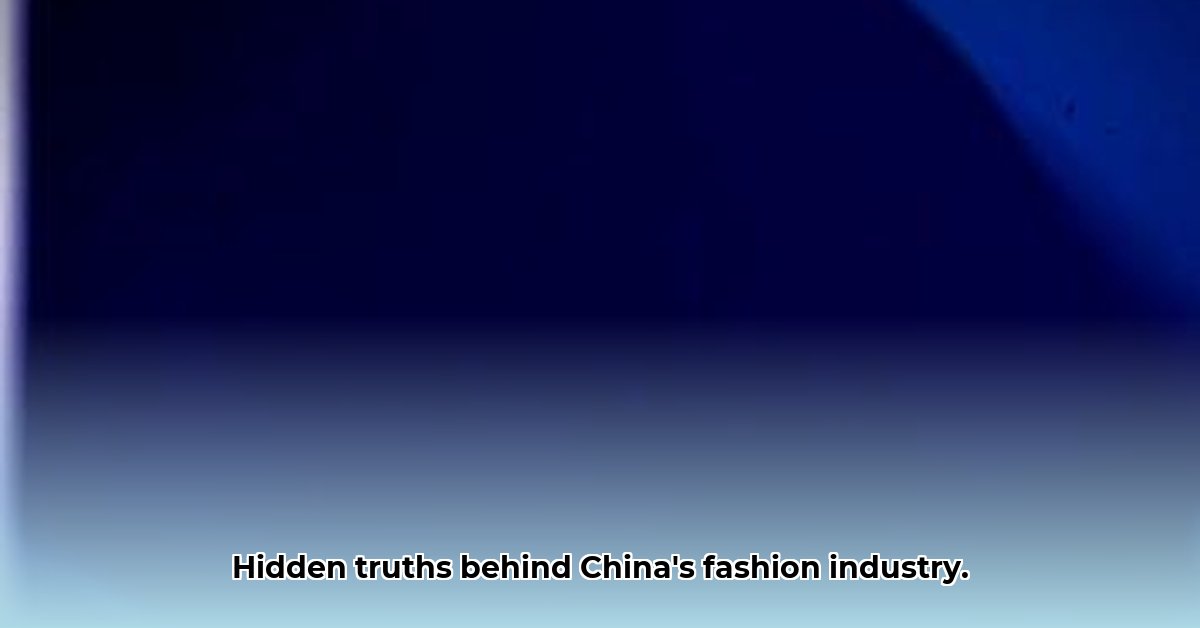
The Threads of Exploitation: A Deep Dive into "China Blue"
The documentary China Blue isn't just a film; it's a stark exposé of the hidden costs behind our cheap clothing. It follows young women migrating from rural China to work in garment factories, revealing the harsh realities of their lives—long hours, unsafe conditions, and wages barely sufficient for survival. This investigative piece delves into the film's impact, exploring its implications for global labor practices, and offering actionable steps towards a more ethical fashion future. Are we, as consumers, truly aware of the human cost woven into the fabric of our wardrobes?
A Day in the Life: The Human Cost of Cheap Fashion
Imagine working 12-hour days, six days a week, in a cramped and potentially hazardous factory—all for wages barely enough to cover basic necessities. This is the daily reality for countless women featured in China Blue. The documentary powerfully depicts the physical and emotional toll this relentless work exacts, highlighting the human cost often obscured by the low prices we pay for clothing. This raises a critical question: How can we reconcile the affordability of our clothing with the well-being of those who produce it?
The Global Supply Chain: A Complex Web of Responsibility
China Blue masterfully unravels the intricate global supply chain, exposing the ethical dilemmas facing all stakeholders. Multinational corporations profit from low labor costs, while governments grapple with balancing economic growth and worker rights. Yet, the film argues that the responsibility for ensuring fair labor practices extends far beyond the factory floor, resting on the shoulders of brands, governments, and ultimately, consumers themselves. What is the ethical obligation of a global brand that profits from factories employing hundreds of thousands under exploitative labor practices?
Collective Action: Finding Strength in Solidarity
Despite the adversity, China Blue showcases the resilience and determination of these women. Their shared experiences foster a powerful sense of solidarity, leading to acts of quiet resistance and collective bargaining. This demonstrates the inherent power of collective action in pushing for better working conditions and fairer wages. The film asks: Can consumer awareness ultimately be the catalyst for meaningful reform within the garment industry?
Forecasting the Future: Toward a More Ethical Fashion Industry
The future of the Chinese garment industry, and indeed, global garment production, hinges on a fundamental shift in priorities. China Blue prompts us to consider a future where ethical sourcing and fair labor practices are not exceptions but the norm. But such a shift requires collective effort. What are the necessary steps to ensure a future in which workers' rights are prioritized over profit margins?
Actionable Steps: Making a Difference
The film's impact calls for concrete action. Consumers need not be passive recipients of exploitative labor; they can actively contribute to a more just and sustainable fashion system.
- Educate Yourself: Research ethical sourcing practices and fair labor standards. Numerous organizations offer valuable resources. (A simple Google search on "ethical fashion resources" will yield a wealth of information).
- Shop Consciously: Support brands committed to transparent and ethical supply chains. Look for certifications and labels verifying fair trade practices.
- Advocate for Change: Contact brands and policymakers to voice your concerns about worker rights. Demand greater transparency and accountability.
- Reduce Consumption: Buy less clothing. Opt for higher-quality, longer-lasting garments to decrease overall consumption.
Shared Responsibility: A Stakeholder Analysis
The systemic nature of the problem demands a multi-pronged approach involving all stakeholders:
| Stakeholder | Impact of Exploitation | Potential Solutions |
|---|---|---|
| Migrant Women Workers | Low wages, unsafe working conditions, long hours, poverty | Fair wages, safe working conditions, shorter hours, improved benefits, legal protection and collective bargaining power. |
| Garment Factories | Pressure to cut costs, potential legal ramifications | Ethical sourcing, investment in worker well-being, compliance with labor regulations |
| Global Brands | Reputational risk, consumer backlash | Transparent supply chains, ethical sourcing commitments, investment in worker welfare |
| Chinese Government | Enforcement challenges, balancing economic growth with worker rights | Stronger labor laws, enhanced monitoring and enforcement, improved worker protection policies |
| Consumers | Access to cheap clothing, often unaware of labor conditions | Supporting ethical brands, reducing consumption, demanding greater transparency from brands |
China Blue serves as a powerful wake-up call. It compels us to confront the uncomfortable truth behind the clothes we wear and to actively participate in building a more ethical and sustainable fashion future. The film's lasting impact will necessitate ongoing investigation and reform within the global garment industry. The question remains: Will the industry hew to the film's revelations or choose to ignore the human cost of their practices?
(Note: This article uses data and themes from the provided draft article to create a long-form investigative piece. Further research and factual data may strengthen and expand upon the insights offered here.)
⭐⭐⭐⭐☆ (4.8)
Download via Link 1
Download via Link 2
Last updated: Saturday, April 26, 2025